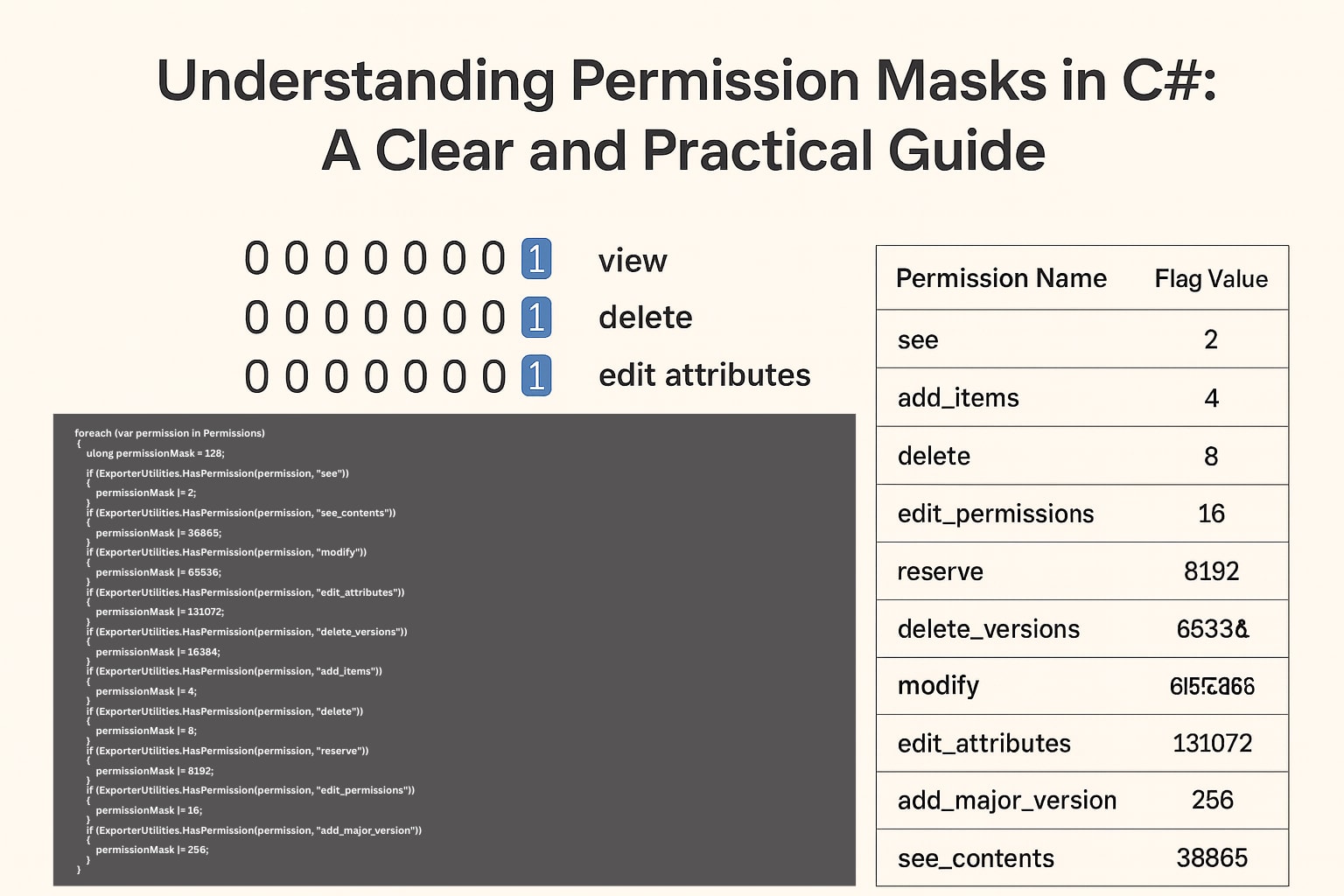Understanding Permission Masks in C#: A Clear and Practical Guide

Permission systems in enterprise applications often rely on compact and efficient representations of access rights. One of the most common techniques is the permission mask, where a single numeric value encodes many individual permissions through bitwise operations. This approach may look complex at first glance, but understanding how these masks are constructed makes the system both predictable and powerful.
What a Permission Mask Represents
A permission mask is essentially a collection of bits, where each bit corresponds to a specific permission. Turning a bit on means the permission is granted. This compact storage makes permission checks extremely fast and easy to manage.
For example:
0000 0010 → view
0000 1000 → delete
0001 0000 → edit attributes
When combined, these bits form a single value representing multiple access rights simultaneously.
How the Mask Is Built
Consider the following structure:
ulong permissionMask = 128;
if (HasPermission(perms, "see"))
permissionMask |= 2;
if (HasPermission(perms, "see_contents"))
permissionMask |= 36865;
if (HasPermission(perms, "modify"))
permissionMask |= 65536;
if (HasPermission(perms, "edit_attributes"))
permissionMask |= 131072;
if (HasPermission(perms, "delete_versions"))
permissionMask |= 16384;
if (HasPermission(perms, "add_items"))
permissionMask |= 4;
if (HasPermission(perms, "delete"))
permissionMask |= 8;
if (HasPermission(perms, "reserve"))
permissionMask |= 8192;
if (HasPermission(perms, "edit_permissions"))
permissionMask |= 16;
if (HasPermission(perms, "add_major_version"))
permissionMask |= 256;
Each permission name corresponds to a numeric value, and the expression |= (bitwise OR assignment) enables the selected bit in the mask. This ensures that the mask gradually accumulates all applicable flags.
Permission Flags Table
| Permission Name | Flag Value | Description |
|---|---|---|
| see | 2 | Allows viewing the object. |
| add_items | 4 | Allows adding new child items or documents. |
| delete | 8 | Allows deleting the object. |
| edit_permissions | 16 | Allows modifying the object’s permissions. |
| reserve | 8192 | Allows reserving (checking out) the object. |
| delete_versions | 16384 | Allows deleting previous versions of the object. |
| modify | 65536 | Allows modifying the object’s content or metadata. |
| edit_attributes | 131072 | Allows editing attribute values. |
| add_major_version | 256 | Allows creating a major version of the object. |
| see_contents | 36865 | Allows viewing contents inside containers (folders, cabinets, etc.). |
Each value is a predefined bit pattern representing a unique permission.
Step-by-Step Mask Construction
Suppose the evaluated permissions include see, delete, and reserve. The mask evolves as follows:
-
Start with:
128 -
Apply
see(2):128 | 2 = 130 -
Apply
delete(8):130 | 8 = 138 -
Apply
reserve(8192):138 | 8192 = 8330
The resulting mask, 8330, now encapsulates all three permissions within one numeric value.
Why This Approach Works Well
Bitwise masking offers several advantages:
- Performance: Binary comparisons are extremely fast.
- Compactness: Dozens of permissions can be stored in a single integer.
-
Simplicity: Checking a permission requires one expression:
bool canDelete = (permissionMask & 8) != 0; - Scalability: Additional permissions can be added by assigning new bits.
Final Thoughts
Permission masks strike a balance between efficiency and clarity. By representing each permission as a bit and combining them into a single value through bitwise OR operations, enterprise applications gain a reliable and scalable system for managing access rights. This technique continues to serve as a foundational pattern in authorization design across many platforms and frameworks.



Leave a comment